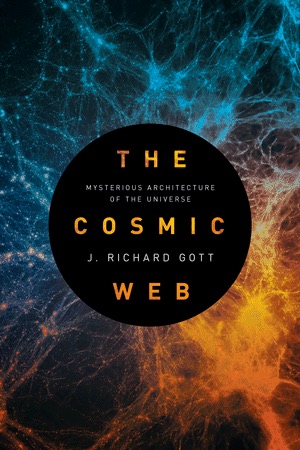Review: The Cosmic Webby Jeff Foust
|
| By the early 1980s, it was clear to astronomers that galaxies were not randomly distributed across the universe but instead, in many cases, concentrated in clusters. |
But what about the Milky Way and the many billions of other galaxies: are they randomly distributed, or is there a structure to them as well? As astronomers have discovered in the last few decades, those galaxies do follow patterns that, in some cases, extend for more than a billion light-years. J. Richard Gott, a Princeton astrophysicist who has been a key figure in understanding that structure, offers a detailed review of those efforts in The Cosmic Web.
By the early 1980s, it was clear to astronomers that galaxies were not randomly distributed across the universe but instead, in many cases, concentrated in clusters. One model developed by American astronomers saw these clusters as high-density “meatballs” isolated in a low-density universe. An alternative model developed by Soviet astronomers offered a “Swiss cheese” approach, with galaxies tracing out an intricate honeycomb pattern, with the voids, rather than galaxy clusters, being isolated.
Around the same time, cosmologists developed the inflation model of the immediate aftermath of the Big Bang. Gott argued that neither the meatball nor the Swiss cheese models for galaxy clusters were consistent with inflation, and offered an alternative “sponge” model, where there is a complex interconnection of high- and low-density regions: the titular “cosmic web.” (This was inspired in part, he writes, by high school research he did on topology that earned him second prize in the Westinghouse Science Talent Search.)
New galaxy surveys created maps of structures that, at first, appeared to support the Swiss cheese model. But, over time, those structures grew ever larger and more intricate, and came to support Gott’s sponge model. Computer simulations, which also became more sophisticated, were able to produce models of galaxy structures using the sponge model that were similar to what astronomers were seeing. These giant structures that exist in the universe today, he writes, are the fossil remnants of random quantum fluctuations from the first instant after the Big Bang.
| “Perhaps no field has benefited more from the computer revolution than astronomy,” he writes. Well, maybe. |
The Cosmic Web is not a book for beginners to astrophysics and cosmology. Gott dives deep into the science and, while not filling pages with equations, doesn’t shy away from variables and mathematics. A sample sentence: “Martin and I calculated that (δρ/ρ)matter should be proportional to M-⅓, where M is the mass scale of the fluctuation.” Not every sentence is like that, to be certain, but enough are to potentially deter math-averse readers.
And there are signs that Gott, as influential as he may be in the development of this field, may have some blinders on. Discussing how advances in computer technology allowed astrophysicists to develop increasingly sophisticated computer simulations of the development of galactic clusters, he writes, “Perhaps no field has benefited more from the computer revolution than astronomy.” Well, maybe, but I suspect scientists in many other fields have examples of how computing advances have revolutionized their research.
Despite these issues, The Cosmic Web is an informative read for those who are interested in how the universe’s largest structures formed thanks to minute fluctuations in the instant after the Big Bang. The book’s last chapter, which discusses the potential end states of the universe as the current acceleration of the its expansion continues, offers a sobering reminder than even these vast structures will not last forever.
